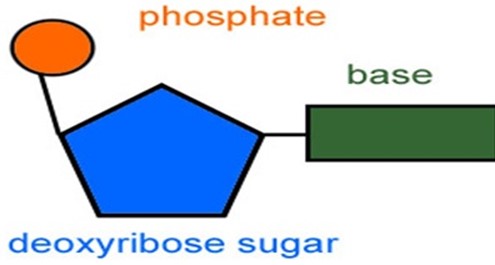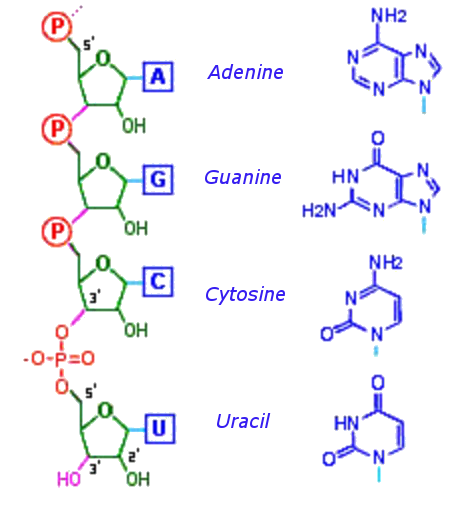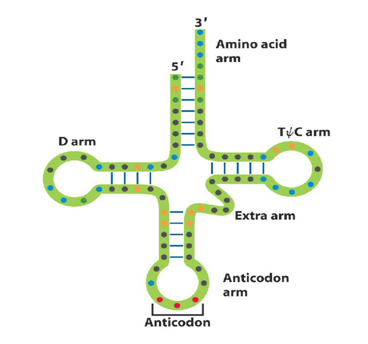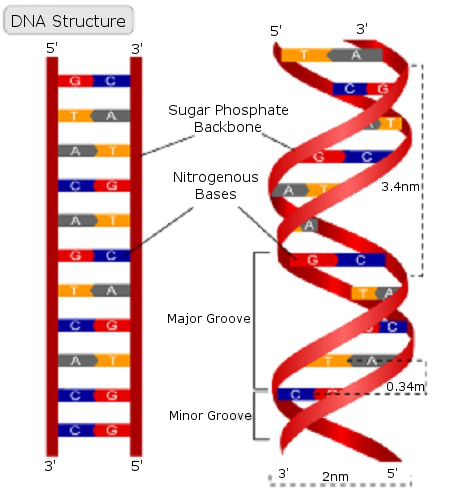Genetics is the study of heredity and variation
Heredity- is the passage of character from one generation to another.
Variation – these are differences among individuals of the same species.
GENETICS & VARIATION
HEREDITARY MATERIALS:-
Hereditary or genetic materials are chemical substances or units on the chromosome that are responsible for the passage of genetic information from one generation to another.
Characteristics of hereditary materials:-
The features that characterize hereditary materials include the following:-
1. Metabolic stability. Hereditary materials are metabolically very stable or chemically inert. If it were altered to any extent, impercfect copies would be made.
2. Mutation: There is a close correlation between hereditary materials and mutation agents that is, when the hereditary materials are exposed to mutagens undergo mutations.
3. Self replication – Hereditary materials are capable of reproducing themselves.
4. Constancy within the cell – The amount of hereditary materials remains constant within a cell or in the cells of organisms of the same species.
5. Carriage of information – The hereditary materials are capable of carrying genetic information from one generation to another.
6. Linearity – The information or the genetic materials if always arranged in a linear array.They are macromolecules
SPECIES CONCEPT:
There are several ways if defining what a species is:-
(a) According to genetics: A species is defined as a group of organisms that share a common gene pool and have the same number of chromosomes. Gene pool is the total of all genetical make up in a given population.
(b) According to ecology: A species is defined as a group of organisms that share a common ecological niche no two species can share the same genetic niche.
(c) According to plant and animal breeding: A species is a group of organisms as that can freely interbreed and produce fertile offspring.
Qn;-How does a breeder define a species?
By the above definition is a horse and donkey of the same species? Give reasons.
SOLN:-
According to definition of species given by a breeder as horse and a donkey are of different species. This is because although they interbreed freely producing a mule but a mule is non – fertile and therefore it cannot produce another mule.
Qn:-In a certain research programme at Kwamsisi Rodent research centre, cage of 159 rats from Usambara mountains and a cage of 162 rats from Pugu forest; reserve were researched. If you were one of the researchers how would you identify those rats of the same species?
SOLN:-
To identify those of same species the following should be done:-
(a) To allow interbreeding:
- Those rats of the same species will interbreed freely and produce fertile offspring.
-
Those rats of different species will either fail to interbreed or if the will inter breed the product so produced will be non – fertile.
(b) Chromosomes analysis:
-
Those rats of the same species will have the same number of chromosome.
EXTRA OF HEREDITARY MATERIALS
Macromolecules
- They are universal but restricted within species.
- All are made due to phosphoric acid.
-
All are comprised of pentose sugar, nitrogen base and phosphate.
CHROMOSOMES AND THEIR STRUCTURE
Chromosomes carry the hereditary – material DNA. In addition they are made up of protein and RNA. Individual chromosomes are not visible in a non – dividing (resting) but the chromosomal material can be seen especially if stained. This material called Chromosomes become visible only during onset of cell division.
Each chromosome is seen to consist of two threads called chromatids joined to point called centromere. Chromosomes vary in shape and size both with and between species.
Homologous chromosomes are similar in structure.
Arrangement of homologous chromosomes in pair is known as Karyograi and the set of chromosomes is known as Karyotype.
Structure of chromosome:-

THE NUCLEIC AIDS, TYPES OF HEREDITARY MATERIALS
There are two types of nucleic acids:-
(a) Ribonucleic acid, RNA.
(b) Deoxyribonucleic acid, DNA.
Chemical nature of nucleic acids:-
Chemically nucleic acids are composed of the following:-
1. Pentose sugar – This is a five carbon sugar.
In RNA, there is ribose sugar where as in DNA, there is deoxyribose sugar.
edu.uptymez.com
2.Nitrogenous (organic) base
There are two groups of organic bases:
(a)Purine bases-
These include: (i) adenine (A)
(ii) guanine (G)
(b)Pyrimidine bases-
These include (i) Thymine(T)
(ii) Cytosine (C)
(iii) Uracil (U)
Note that;
Thymine is a DNA pyrimidine while Uracil is an RNA pyrimidine. No uracil in DNA nor is there thymine in RNA
3. Phosphate group:-
This is derived from phosphoric acid and it is this group that makes compounds (DNA and RNA) acidic in nature.
The three components are combined by condensation reactions to give a nucleotide. By a similar condensation reaction a dinucleotide is formed and continued condensation reaction leads to the
formation of a polypeptide.The main function of nucleotides is the formation of nucleic materials RNA and DNA which have vital roles in protein synthesis and heredity.
Structure of a typical nucleotide:-

- Chemical bonds:-
edu.uptymez.com
There are two types of chemical bonds:-
Phosphodiester bonds – These hold the nucleotides together.
Hydrogen bonds – These hold together the complementary base pair in DNA as well as RNA.
- Protein cost:-
edu.uptymez.com
The DNA of the eukaryotes has a history protein coat over its surface.
(A) RIBONUCLEIC ACID (RNA)
Chemical nature:-
Ribonucleic acid is chemically composed of the following substances:-
(a)
Pentose sugar – This is a 5 carbon sugar called ribose.
(b)
Phosphate group– derived from phosphoric acid.
(c)
Organic (nitrogenous) bases – These are of two types.
(i) Purines – These are Adenine (A) and Guanine (G).
(ii) Pyrimidines – These are Uracil (U) and Cytosine.
(d) Chemical bonds: These are of two types:-
(i) Phosphodiester bonds – Which hold the nucleotides together.
(ii) Hydrogen bonds – Which hold together the complementary base parts in tRNA molecule.
Diagram to show structure of RNA:

Role of RNA.
The role of RNA is situational:-
- In the presence of DNA, RNA in collaboration with DNA.
edu.uptymez.com
Controls heredity.
Controls protein synthesis.
- In the absence of DNA, RNA alone.
edu.uptymez.com
Controls heredity.
Controls protein synthesis.
Types of RNA
-
According to function and location in the cells, there are three types of RNA:-
(a) Messenger RNA (mRNA).
-
This is the type of RNA formed from one of the strands of DNA in the process called transcription.
Role of mRNA:-
-
Messenger RNA carries the genetic code from DNA in the nucleus to the ribosome in the cytoplasm. This genetic code contains the information about the types of amino acids that should be joined together to form a protein molecule.
(b) Ribosomal RNA (rRNA).
- Ribosomal RNA (rRNA) or soluble RNA constitutes about 80% of the total RNA in the cell.
- Ribosomal RNA is synthesized by a special DNA found in the nucleolus at a special region called a nucleolar organizer.
-
It makes a bulk of the ribosome.
Role of rRNA
(i) It is an integral part of the ribosome i.e large proportion of the ribosome is made up on rRNA.
(ii) It attracts other types of RNA i.e mRNA and tRNA towards the ribosome during protein synthesis.
(c) Transfer RNA (tRNA)
edu.uptymez.com
-
- This constitutes about 15% of the total RNA in the cell.
- Structurally, tRNA is a clover – lead shaped molecule with a folded loop – like chain.
- The looping of the chain, results into pairing of the folded of organic bases. Hence the formation of hydrogen bonds.
- The molecule has got four active / recognition sites.
-
The upper site recognizes an amino acid, where as the lower side (Anticodon) recognizes the mRNA. One of the sides recognizes the ribosome where as the other one recognizes in enzymes, amino – acyl tRNA synthetase.
Role of tRNA
The role of tRNA is to carry the activated amino acids from various parts of the cytoplasm to their binding site, the ribosome.

-
(B) DEOXYRIBONUCLEIC ACID (DNA)
Chemical nature:-
DNA is chemically composed of the following substances:
(i) Deoxyribose sugar– This is a pentose (5 – carbon) sugar.
(ii) Organic or nitrogenous bases – These are of two categories.
(a) Purine bases – These are Adenine (A) and Guanine (G).
(b) Pyrimidine bases – These are Cytosine (C) and Thymine (T).
Base pairing rules:-
- Since DNA is double stranded molecule, the bases on the two strands appear in pairs being held together by the hydrogen bonds.
- The strands run in opposite directions, that is are Antiparallel.
- The base pairing rules make the chains, Complementary.
-
According to Watson – Crick modal of DNA structure, a purine pairs with a pyrimidine. The rules are that:
(a) Adenine pairs with thymine and the two bases are held together by two hydrogen bonds.
(b) Cytosine pairs with guanine and the two bases are held together by three hydrogen bonds.
(iii) Phosphate group – dividend from phosphoric acid.
(iv) Protein – Over the surface of DNA, there is a histone protein coat.
(v) Chemical bonds – There are two types of chemical bonds.
(a) Phosphodiester bonds – These hold the nucleotides together.
(b) Hydrogen bonds – These hold the complementary base parts together.
Diagrammatic structure of DNA:-

-
Role of DNA in protein synthesis.
This role of DNA is that, it instructs the cell of the types of amino acid that should be initiated to form a protein molecule. That is the message contains the information about the types of amino acids that should be joined up forming the protein molecules
Qn:-One of the characteristics of DNA as a hereditary material; is that it is metabolically very stable. State the features of DNA that account for this metabolic stabilit
Answer;-
The features of DNA account for this metabolic stability include the following:-
(a) Possession of a histone protein coat
(b) The helical nature, increases mechanical strength.
(c) The chemical bonds i.e hydrogen and phosphodiester bonds, increase mechanic strength.
Evidence for the role of DNA in inheritance
It took many years to clarify whether genetic material was the DNA or the protein the chromosomes. It was suspected that protein might be the only molecule with staff verify of structures to act as genetic material.
Evidence from bacteria:
In the days before development of antibiotics pneumonia was often a fatal disease. It was intended in developing a vaccine against the bacterium Pneumococcus which was one form of pneumonia.
Two forms of pneumococcus where known, one covered with a gelalinious capsule one violent (disease producing) and the other non – capsulated and non – violent. The capsule protected the bacterium in some way from attack by immune system of the host.
Griffith hoped that by injecting the patients with either the non – capsulated the heat – killed capsulated forms, their bodies would produce antibodies which would give protection against pneumonia. In a series of experiments he injected with both forms of pneumococcus and obtained the results shown in a table below. The dead mice revealed the presence of live capsulated forms their bodies. On the basis of these results Griffith concluded that something must be passing from the heat – killed capsulated forms to the live non – capsulated forms which caused them to develop capsule and become virulent.
However the nature of this transforming principle, as it was known was not isolated and identified until 1994.
Results of Griffth’s experiments:-
edu.uptymez.com
| Injected form of pneumococcus | Effect |
| Live non – capsulated | Mice live |
| Live capsulated | Mice live |
| Heat – killed capsulated | Mice live |
| Heat – killed capsulated | Mice live |
| Heat – killed capsulated + live non capsulated | Mice live |
edu.uptymez.com
Later on analysis on the constituent molecule of heat – killed capsulated pneumococcal cells and testing their ability to bring about transformation in live non – capsulated cells. Removal of the polysaccharide capsule and the protein much from the cell extracts had no effect on the transformation, but the addition of the enzyme deoxyribonuclease (DNase), which hydrolyses (break down) DNA prevented transformation. Hence, demostration of the Griffth transforming principle basing on the fact of DNA.
Evidence from viruses:-
Experiment on bacteriophage which attacks the bacterium, it concluded that DNA physical and not the protein which is the hereditary materials.